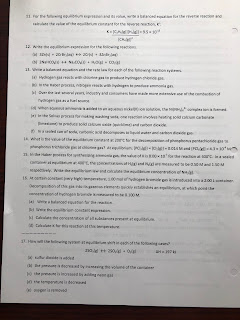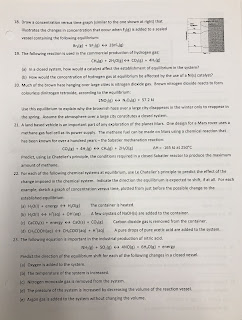- All reactions are considered to be reversible.
- The forward and reverse reaction rates will eventually become identical – at this point we have equilibrium. Thus, for the reaction A ↔ B, when the [A] and [B] no longer change, equilibrium is reached. This is because the ratef = rater
- When equilibrium is reached, the reactions don’t stop – the forward and reverse reactions continue, but at the same rate. We indicate that the equilibrium is dynamic by using ↔.
When at equilibrium, a reaction is said to have attained steady state, displaying:
- constant macroscopic properties (for instance, colour of the system stops changing or the amount of precipitate remains static)
- continuous microscopic properties (the forward and reverse reactions continue at the microscopic level)
- the same equilibrium can be reached from either reactants or products (since the reaction is reversible and can run in either direction)
 |
| Graphical representation of a reaction. The point at which the forward and reverse reactions run at the same rate is called equilibrium and it begins at the dotted line. |
There are several types of equilibrium, including, but not limited to:
- phase equilibrium H2O(l) ↔ H2O(g)
- reaction equilibrium CaCO3(s) ↔ CaO(s) + CO2(g)
- solubility equilibrium NaOH(s) ↔ Na+(aq) + OH-(aq)
This video explaining equilibrium is super duper neat.
ICE Tables – Calculating Concentrations
at Equilibrium
First
things first: what is ICE? This might
answer your question.
um...okay...actually, I = initial [ ], C = change in [ ], E = equilibrium [ ]. We will be using ICE tables for several weeks, so let's get this party started...
ex. A 1.000 L flask is filled with 1.000
mol H2 and 2.000 mol I2 at 448°C. At equilibrium, the concentration of I2
was measured at 1.065 M. What are the
equilibrium [H2] and [HI]?
Answer:
- Set up an ICE table, using the balanced reaction equation.
- Fill in given data (ICE tables always use concentration values – feel free to exclude units in the table, but be sure to reintroduce them in the final answer. Notice that the initial concentration of HI is 0M because at the start of the reaction, we would have no products yet.
- Use logic to fill in the remainder of
the table: For I2, if we start with 2.000 M and end with
1.065 M, the change would be -0.935 M. If the change for I2 is -0.935 M, it must
be the same for H2, due to the 1:1 mole ratio. Similarly, if the change
for I2 is -0.935 M, it must be double for HI, due to the 1:2 mole
ratio. The only difference is that the sign is now "+" because products are being formed.
- Determine equilibrium concentrations for H2 and HI by simply adding the “Change” to the “Initial” in each of the columns.
H2(g) + I2(g) ↔ 2HI(g)
I 1.000 2.000 0.000
C
-0.935
-0.935 +2(0.935)
E
0.065 1.065 1.87
so, [H2] = 0.065 M and
[HI] = 1.87 M
Homework #1-7
Answer Keys are here.
Student Questions:
1. Can you go over number 3 and 5 from the homework?
#3 ↝ If we don't reseal an open bottle of soda, the carbon dioxide (which makes the pop fizzy) can escape (that "psst" noise when you take the lid off of the bottle). If the carbon dioxide escapes, then the reverse reaction (where the carbon dioxide redissolves in the soda) cannot occur. Thus, we get flat soda (ew).
#5 ↝ Follow along using the answer keys:
Using the balanced reaction equation, set up the ICE table. We are told that we have 2.0 mol of NOCl in a 2.0 L flask, so the initial [NOCl] is 1.0 M. The initial [NO] and [Cl2] are 0 M since they are products and have not formed yet.
We are told the eq [NO] is 0.032 M, so to get from in [NO] of 0 M to eq [NO] of 0.032 M, we have to have a change of + 0.032 M. For Cl2, the change will be the same as that for NO, since there is a 1:1 stoichiometric relationship between them. For NOCl, the change will be double in magnitude, but opposite in sign to that for NO, since there is a 2:1 stoichiometric relationship between them. Also, the sign is negative (-0.064 M) because as the reaction proceeds reactants are consumed.
To determine the eq [NOC], [NO] and [Cl2], simply add the change to the initial in each respective column.





